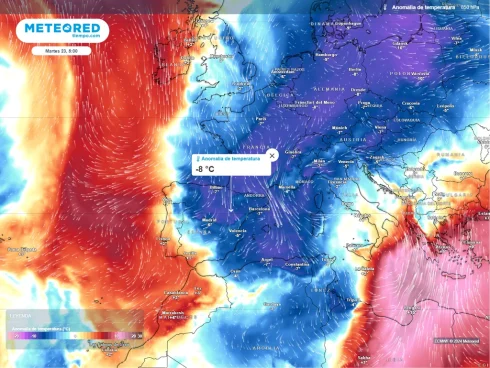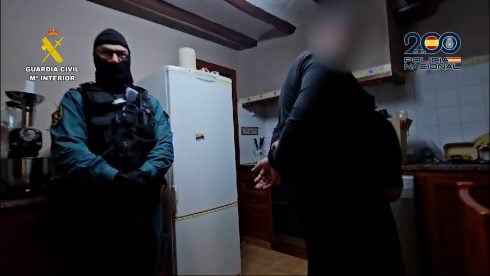by Bob Maddox
Forty one years ago last week, a mid air collision between two US Air Force planes during refueling led to four nuclear bombs – each 100 times more powerful than that which flattened Hiroshima – falling on the fishing village of Palomares in Almería.
AT 10.20 am on January 17, 1966, Francisco Simo Orts, a fisherman from the Almerian village of Palomares, lay five miles offshore aboard his shrimp boat, Manuela Orts. It was a beautiful Mediterranean morning, with perfect visibility under an azure sky and Orts was preparing to raise his shrimp nets.
At 31,000 feet above him, Major Larry Messinger of the US Air Force, was involved in a somewhat trickier operation – maneuvering a 220 ton B52 Stratofortress into place beneath the belly of KC 135 Stratotanker in preparation for a scheduled mid-air re-fuelling over eastern Spain. The B52 was on the return leg of a journey that had taken it from Seymore Johnson Air Force Base, North Carolina, out over the Atlantic Ocean and across Europe, to touch the borders of the Soviet Union. The year was 1966; the Cold War was at its height and U.S. nuclear deterrence at the time hinged about an operation codenamed Chrome Dome. In practice, this meant at any given moment, day and night, a fleet of B52 bombers, armed with nuclear weapons, were prowling around the borders of the Soviet Union, ready to deliver Armageddon to the heart of the enemy.
Critics of Chrome Dome had long pointed out the dangers involved in this and, in particular, the potential for an accident involving “live” nuclear weapons. As Simo began to tend his nets, events were taking place in the sky above him which would trigger the most expensive search in history and change US defence policy forever.
As the giant bomber nuzzled into place beneath the Stratotanker, something went wrong with the manoeuvre. The B-52 rammed the underbelly of the tanker, splitting it open and showering the bomber with its contents – 40,000 gallons of flammable aviation fuel. As the fuel was sucked in by the huge engines of the B-52, a series of explosions were triggered that tore both planes into pieces; killing the KC-135’s crew of four and three men in the tail section of the B-52.
Four others, Captains Charles Wendorf and Ivens Buchannan, Lieutenant Richard Rooney and Messinger himself, ejected from the stricken bomber and began the long, slow fall towards Palomares. All four were later picked up safely.
In a bizarre twist of irony, five of the dead crewmen fell to earth inside Palomares village cemetery and the remaining two just a stones throw away.
Hispanic Hiroshima
But they were not alone. Also falling through the Adalucian sky that morning were four Type B28RI nuclear weapons; H-Bombs. Equipped with warheads of 1.45 megatons, each bomb packed around 100 times the punch of the bomb that destroyed the Japanese city of Hiroshima in August 1945.
From his boat, Simo Orts saw the explosions; an orange fireball against the sky which trailed flaming debris; fingers of black smoke pointing down at the village of Palomares. Minutes later, he was startled to see a parachute falling near his boat trailing what he later described as “…a dead man.” To Orts’ distress this hit the water and disappeared, before he could race to recover the body. The “dead man” was in fact the only one of the released nuclear weapons to have drifted out to sea on its parachute. As Simo raced towards the spot, the B28RI was already sliding down towards the dark bed of the Mediterranean, 2,850 feet below.
Paradoxically, a hydrogen bomb is one of the safest devices ever devised. In each bomb a primary trigger, in this case plutonium, is surrounded by a precisely shaped sphere of conventional high-explosive lenses. For a nuclear explosion to occur, these high explosive lenses must be detonated simultaneously, sending a precisely shaped shock wave inwards to squeeze the plutonium and trigger a chain reaction. This, in turn, triggers a thermonuclear reaction which in effect turns the bomb into a miniature star many times hotter and brighter than the sun. Bang.
However, this is extremely high-tech stuff and highly unlikely to happen in an accident. Good news for Andalucía and for the people of Palomares in particular, since three of these bombs were now on the way down to pay them a surprise visit.
The crash itself was witnessed by several villagers. The refueling operations were a daily occurrence and villagers often paused to watch the delicate aerial ballet taking place high above them. Maria Badillo was preparing lunch when her little daughter ran into the house screaming “Mama! The sky is raining fire!” Grabbing her three children, Maria took refuge as huge sections of American nuclear bomber crashed around her house.
One hydrogen bomb fell directly in front of 83-year-old Pedro de la Torre Flores and his two young grandnephews who were busy watching flaming plane debris shower down around them. Its parachute had failed and as the bomb crashed into the ground at 135 feet per second, its high explosive trigger detonated on impact, throwing all three to the ground. Attracted by the commotion, Pedro’s nephew, José López Flores ran to help. The bomb was now on fire and José, fearful of more explosions, began to stamp out the flames with his feet. In doing so, he may have become perhaps the only person in history to have actually danced on a hydrogen bomb.
A second bomb was found on the other side of Palomares by Alfonso Flores Serrano. Although there had been no explosion this time, Alfonso noticed the bomb’s casing had cracked open on impact, spilling a brown dust, but otherwise, he left the weapon alone.
Bomb number three landed in the nearby Cabezo Negro Hills. Like the first, it had detonated its high explosives, flinging debris and a black-brown cloud of plutonium dust over a wide area.
Search
By 10.22am, it was all over. Astonishingly, no one on the ground had been hurt as pieces of the two giant aircraft and their deadly cargo crashed to earth in fiery ruin across Palomares. The two explosions had released plutonium dust over a wide area, which was then further scattered by the wind, seriously contaminating crops and agricultural land. But radioactive tomatoes were the least of the problems now facing the U.S. Air Force.
Over the next few days as hundreds of U.S. soldiers began to comb the countryside for bomb number four, it became increasingly apparent a rather embarrassing situation was developing. The United States had lost a large hydrogen bomb in a very public fashion in someone else’s country – and it had absolutely no idea where to begin looking for it.
U.S. President Lyndon Johnson was about to signal the start of the biggest, most expensive and most frantic hunt in history; and a simple Andalucian fisherman named Simo Orts was about to become world famous.







Hello and sorry to bother you. When I was young, my mother told me our family was related to Francisco Simo Orts. I learned later that the Simo family home, still in Menorca, is now the Capo-Simo family. I would love to get in contact with long-lost relatives I’ve never had the pleasure to meet. If anyone knows of a way I might be able to contact them, please give them my information.
John Simo Villarreal
1021 Melanie’s Walk
Pflugerville, Texas USA 787660
512-670-0478 home 512-296-6355 cell
[email protected]
I am from the family line of two brothers that came from a shrimping/steamboat engineering family= Juan and Jose Simo via Baton Rouge, Louisianna and Port Isabel, Texas and Brownsville, Texas.
I genuinely appreciate your assistance.
Take Care and God Bless,
JSV
The questions that were asked by the american airforce, but not in public was why the four bombs, armed and ready, did not explode. Tests showed that their entire nuclear arsenal was useless due to faulty design of the detonating explosive. This was obviously kept secret because it would have given Russia an absolute advantage in the cold war. This is true as I was told it by a very high ranking american airman who was flying from the same airbase a the lost plane.
As to why the bombs did not produce a nuclear explosion is due to the safety features of the bomb. Only if all the arming sequences are activated can such an explosion occur. Otherwise a smaller explosion can occur with only some of the components spilling out such as what happened to those that landed on land at Palomares. It was a very unfortunate accident that was caused by PILOT ERROR! It is a date that is etched in my memory because I was in the other B-52 that was simultaneously refueling. Also, it was our 2nd refuelling and we had a lot of airspace yet to travel, from the site of the accident to the far eastern reaches of the Mediterranean west to our return to Seymour Johnson AFB, N.C. Also not mentioned was the fact that Wendorf violated SAC policy by allowing Messinger to be in the seat for refuelling. Lt Rooney did not eject but made a manual bailout thru the open hatch created below by the ejection of Major Buchannon.
My father,
Major Larry G. Messinger was the pilot of the B-52 and isn’t it interresting that NO ONE has ever bothered to interview HIM to find out the REAL truth about what happened that day. There was NO mid-air collision as is widely touted as the reason for the crash. But again, NO ONE has bothered to go to my father to get the facts. Not the US Air Force and few, if any others who have written so-called books about the event.
The B-52 NEVER Rammed the underbelly of the tanker! My father was an accomplished pilot and had more hours in the air than almost any pilot on record. With all of the fuel in the air at that altitude and with the conditions being such there was a fuel ignition but NO deliberate crash whatsoever. Let’s set the record straight once and for all. The B-52 my dad was pilot of never rammed the belly of the tanker.
In 2003 our team interviewed for the first time to Larry and Marian for the film documentary “Operación Flecha Rota. Accidente Nuclear en Palomares” (Broken Arrow. Nuclear Accident in Palomares). After Barbara Moran for his book: “The Day we lost the H.-Bomb”, and after for the spanish Antena 3 TV.
It’s unfortunate this happened but what is just as sickening is the fact that this idiot Simó Orts, went with his lawyer to the courthouse in NYC, and claimed salvage rights. Because of “customary” maritime law, if a identifying the location leads to a successful recovery, the person usually gets a small fee (1 to 2 percent of the value of the item). Now, what is the value of a Hydrogen Bomb?? Per Wikipedia, it was valued at 2 Billion by the Secretary of Defense. He settled out of court for a undisclosed sum.
I wish the bomb would have detonated right on his boat!! One less greedy pr*ck to populate the earth!!!
Very interesting story. I believe that this accident led to the “re-examination” of the Chrome Dome operations – operations guaranteeing the presence of B-52 bombers flying around the Arctic Circle incase of a Soviet “first strike”.
About the comment above: With all of the hype about this accident and the danger that it caused people in the area, plus the time and effort it took a probably, modest fisherman to locate the bomb, I think that some compensation is due. I’ll agree that 20 million too much, but I see where you could argue for a settlement.
Does anyone know where I can see maps/ plans of the incident
Property has been built and occupied on a large scale in Palomares and the owners are not told about the incident but find out later.
Is this you ??
Happy new year 2010
RoC: If Simó Orts managed to claim salvage rights successfully, then he was no idiot, was he? I don’t know about greedy, but Spain was dirt poor at the time, the US living in a completely different financial universe, they come to his country setting up military bases and spreading radioactive s**t around his village, he did actually helped them find it… What I say is, I hope the payout was cool. PS. YOU, on the other hand, are so intelligent and wish for a hydrogen bomb to explode by accident in a populated area?
@Nigel Hammond:
I have very recently (this week) bought property in Palomares Bajo, and yes, nothing whatsoever has been mentioned about this incident by anyone, I found out/heard the very next day by locals. Nobody really seems to worry too much, but that seems more given in by the Spanish nature than by any scientific or official communication.
I know of no maps or plans but we know where the cemetary is and where the Cabezo Negro Hills are.
I am not worrying but am interested in knowing more details, contact me if you can/want.
@ROC: Obviously you know little of history. If it hadnt been for the fisherman the US might have never recovered the bomb, or worse, the Russians could have. On the other hand, the Franco government did not have much of a problem sacrificing part of the population for the better of the so called upper class..who would be the greedy bastards?Not the fisherman.
Saludos
BBC runs a story today on the event:
“http://www.bbc.co.uk/news/magazine-18689132”
@Melissa Messinger, if it was not a pilot error, what was the cause?